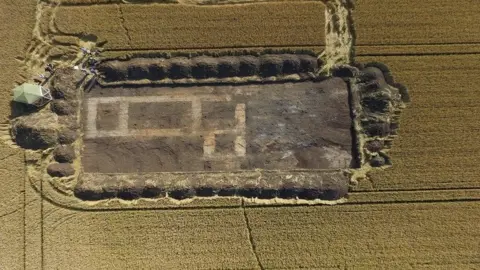Ancient henge discovered near Crowland Abbey
 The Anchor Church Field Project
The Anchor Church Field ProjectArchaeologists have uncovered evidence of an ancient henge near the ruins of a medieval abbey in Lincolnshire.
Material including pottery, two bone combs and fragments of glass were found, along with the remains of a 12th Century hall and chapel.
The discovery was made in Anchor Church Field in the area of Crowland Abbey.
The henge is one of the largest discovered in eastern England, according to those involved.
Experts said it showed the site had been a sacred and prominent place for ceremonial activity for longer than previously known.
A henge is a prehistoric circular or oval earthen enclosure and, according to English Heritage, there are fewer than 100 left across the UK and Ireland.
The discovery was made by a team from Newcastle University and also included experts from the University of Sheffield.
 Heritage Images/Getty Images
Heritage Images/Getty ImagesThe area was the site of an Anglo-Saxon hermitage belonging to St Guthlac, who died in 714.
He was known for his life of solitude, having given up a life of riches as the son of a nobleman.
It was around Guthlac's lifetime that the henge was reoccupied, experts said.
 The Anchor Church Field Project
The Anchor Church Field ProjectDr Duncan Wright, lecturer in medieval archaeology at Newcastle University, said: "We know that many prehistoric monuments were reused by the Anglo-Saxons, but to find a henge - especially one that was previously unknown occupied in this way is really quite rare.
"Although the Anglo-Saxon objects we found cannot be linked with Guthlac with any certainty, the use of the site around this time and later in the medieval period adds weight to the idea that Crowland was a sacred space at different times over millennia."
The hall and chapel discovered was thought to have been used as accommodation for high-status pilgrims visiting Crowland.

Follow BBC East Yorkshire and Lincolnshire on Facebook, X (formerly Twitter), and Instagram. Send your story ideas to [email protected]
